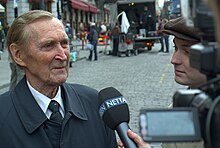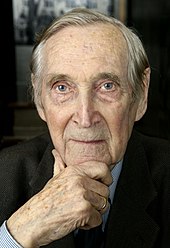Gunnar Sønsteby
Gunnar Fridtjof Thurmann Sønsteby DSO (born January 11, 1918 in Rjukan ; † May 10, 2012 in Oslo ) was a Norwegian resistance fighter during the German occupation from 1940 to 1945. He was the most highly decorated Norwegian citizen.
Life
Together with Max Manus , Sønsteby was one of the leading figures of the so-called Oslogjeng (Oslobande) from 1943 to 1945 and was involved in a large number of acts of sabotage during the war . He operated under 30 to 40 different aliases (including Kjakan, No. 24). It was only towards the end of the war that the Gestapo managed to find out his real name. But even though she was closely on his heels at times, she never succeeded in arresting him.
Childhood and youth
Sønsteby grew up in the small industrial town of Rjukan in Telemark in southern Norway . Even as a schoolboy, he spent a lot of time with his comrades on hiking tours in the surrounding mountains.
After graduating from high school in 1937, Sønsteby moved to Oslo , where he did his military service and began studying social economics. There, too, he cultivated his passion for mountain tours and skiing. Many of his tour mates - including Knut Haugland , Halvor Rivrud , Olav Skogen , Leif Nilsen , Rolf Solem , Turjus Aarnes , Knut Berge and Einar Nordgaard - were later also active in the Norwegian resistance.
Occupation and Resistance
When German troops occupied Norway on April 9, 1940 , Gunnar Sønsteby worked as an accounting assistant. He joined Norwegian units in the east of the country and followed them to Østre Gausdal , but soon after was hospitalized with pneumonia.
In the same year Sønsteby began to get involved in the burgeoning resistance movement in Norway, where he was initially active in the circle around the student leader Knut Møyen . He was - among others with Max Manus - also involved in the publication of the illegal newspaper Vi vil oss et land (“We demand a land for us”).
In 1941 he went to Sweden, where he came into contact with the Special Operations Executive (SOE), a secret British military unit tasked with supporting acts of sabotage in countries occupied by Germany. After an unsuccessful attempt to get to Great Britain unnoticed - Sønsteby suffered frostbite on his leg on the way to Ålesund - he carried out various courier and reconnaissance missions in Norway for the British embassy in Stockholm . In 1942 he was interned by the Swedish police and spent three months in prison until he finally managed to convince them that he was not the wanted Gunnar Sønsteby.
During the course of the year, the SOE deployed him as an agent and shop steward in occupied Oslo. Under the code name “No. 24 ”he built up a network of conspiratorial apartments and made contacts with other resistance groups. During this time he worked with Organization 2A and Asbjørn Sundes Osvald Group . Contact with the Milorg was through Knut Møyen.
On February 23, 1943 Sønsteby's father Gustav was taken into kin custody and interned in the Grini prison camp until December 1944 .
After narrowly escaping the Gestapo himself in April 1943, Sønsteby fled to Stockholm again. From there he was sent to Great Britain and in June 1943 integrated into the Linge Company (Norwegian Kompani Linge , actually Norwegian Independent Company No. 1 , NORIC 1). After training in the secret service, he was parachuted back over Norway in October and initially worked as a “man for all cases” for his friend Knut Haugland. Later he took over the role of the action leader in the central leadership of the Milorg as well as the leadership of the sabotage group Oslogjengen .
Sabotage in which Sønsteby was significantly involved:
- Attack on the Central Bank of Norway in autumn 1942, which secured printing plates for Norwegian banknotes for the government- in- exile in London .
- The archive and later the punched card machines at the Arbeidkontorets in Oslo, which presumably saved many Norwegian men from being sent to the Eastern Front , were blown up (June 1943).
- Blasting of German aircraft engines and other aircraft parts in a warehouse in the Bjølsenhalle in the Moldegate in Oslo (August 1944).
- The Kongsberg arms factory was blown up in September 1944.
- Capture of a shipment with 75,000 rationing cards.
Gunnar Sønsteby's nickname Kjakan (dt. The chin) comes from the alias Umulius Kjakabråten , with whom he was known in Oslogjeng .
Work and life after the war

After the end of the war, Sønsteby moved to the USA, where he studied at Harvard Business School . Before returning to Norway, he worked in the oil industry there for several years. In his home country he worked as a self-employed entrepreneur.
In the post-war years, but especially when he reached retirement age, Sønsteby toured home and abroad with lectures and information events in order to bring the lessons of the Second World War to the next generation.
In honor of his 90th birthday in January 2008, King Harald of Norway hosted a reception at Akershus Fortress , at which all members of the royal family were present.
Even after his 90th birthday, Sønsteby was on the road a lot. On the occasion of the shooting of the film Max Manus in spring 2008 , in which he was played by Knut Joner , and during the special screenings of the film in 2009, he was available for interviews in Scandinavia.
honors and awards
Sønsteby was Norway's most decorated citizen. He was the only bearer of the War Cross with Three Swords (awarded on August 16, 1946). Among the many awards that Sønsteby was allowed to receive in the course of his life, there were not only those from his home country but also some foreign medals:
- 1945: Medal of Freedom with a silver palm (USA)
- 1946: War cross with three swords ( Krigskors med tre sverd , Norway)
- 1946: Commemorative medal of His Majesty the King in silver ( HM Kongens Erindringsmedalje , Norway)
- 1946: Distinguished Service Order ( United Kingdom )
- since 1969: namesake for the Sønstebynuten in the Antarctic
- 2001: Culture Prize of the American-Scandinavian Society (USA)
- 2002: Freedom Award from the Association of Former Intelligence Officers (USA)
- 2004: Defense medal with a laurel branch ( Forsvarsmedaljen med laurbærgren , Norway)
- 2006: Commander of the Order of Saint Olav (Norway)
- 2008: Special Operations Command Medal (USA)
- 2012: Cross of Honor of the Armed Forces ( Forsvarets hederskors , Norway)
His home commune Tinn in Telemark made him its first and so far only honorary citizen in 2002. In addition, since 2005 he was the first honorary student of the Rjukan videregående skole (comparable to the grammar school upper level in Germany).
King Harald of Norway unveiled a statue of Gunnar Sønstebys by Per Ung on May 13, 2007 at the Solliplass in Oslo . It shows the 25-year-old resistance fighter next to his bicycle. In 2012, this memorial was moved to Karl-Johans Gate, directly opposite the university, within sight of the castle.
In December 2007, readers of the Norwegian daily Aftenposten voted Sønsteby Osloer of the Year. The ceremony took place on December 21, 2007 in the Norwegian Resistance Museum (Norges Hjemmefrontmuseum) at Akerhus Fortress.
In autumn 2008, the Trondheim student association (Studentersamfundet i Trondheim) awarded him honorary membership for his commitment to Norway.
Trivia
A cycling shop in Bremen bears the name "Sønsteby's" in honor of Gunnar Sønstebys, who used to cycle to many of his activities.
literature
- Sønsteby, Gunnar: Report from # 24. New York: Barricade Books, 1999, [Reprint. of the edition] New York: Stuart, 1965, ISBN 1-56980-141-X (Norwegian original edition: Sønsteby, Gunnar: Report fra nr. 24. Oslo: Orion Forlag, 1996, ISBN 82-458-0153-4 ).
Web links
- Literature by and about Gunnar Sønsteby in the catalog of the German National Library
- Homepage for and about Gunnar Sønsteby (Norwegian, English)
- Contemporary witness report on arte.tv
Individual evidence
- ^ Eddie Rustad: Oslo-gjengen. October 29, 2003, archived from the original on June 13, 2004 ; Retrieved November 8, 2008 (Norwegian).
- ↑ Catherine Stein: War hero turns 90. In: Aftenposten.no. January 11, 2008, archived from the original on January 15, 2008 ; accessed on June 9, 2018 .
- ^ Marit C. Anderssen: Så manus bli film. In: Romerikes Blad . April 15, 2008, accessed April 16, 2008 (Norwegian, interviews and photos for the film Max Manus).
- ^ Culture: "Max Manus" på svenska biografer. Official Norwegian website for Sweden: Gunnar Sønsteby at the Norwegian Film Days in Stockholm 2009 ( memento from September 14, 2012 in the web archive archive.today ) from April 30, 2009.
- ↑ Håkon Høgetveit: Levende legend på sokkel. May 14, 2007, archived from the original on September 30, 2007 ; Retrieved November 8, 2008 (Norwegian).
- ↑ Katharina Hirsch: Resistance fighter is the godfather: “Sønsteby's cycling and workshop” has ordered a mural. In: Weser-Kurier.de. March 2, 2014, accessed June 9, 2018 .
| personal data | |
|---|---|
| SURNAME | Sønsteby, Gunnar |
| ALTERNATIVE NAMES | Sønsteby, Gunnar Fridtjof Thurmann (full name) |
| BRIEF DESCRIPTION | Norwegian resistance fighter from the time of the German occupation |
| DATE OF BIRTH | January 11, 1918 |
| PLACE OF BIRTH | Rjukan |
| DATE OF DEATH | May 10, 2012 |
| Place of death | Oslo |

